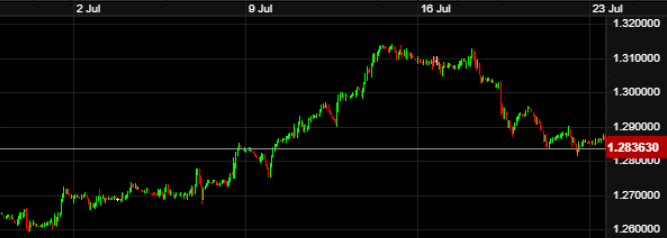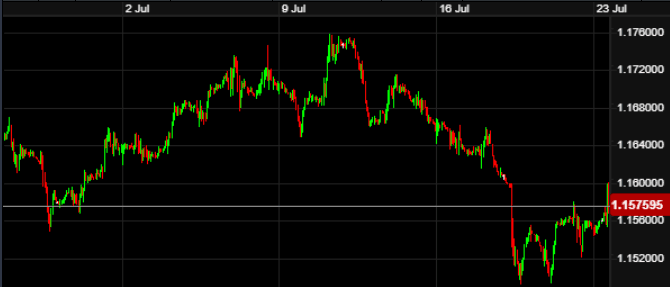ACM Update 24-07-23

Sterling spent last week mirroring the fourth Ashes Test at Old Trafford… a great start but slipping away towards the end. The British weather can’t take any of the blame for moves on GBP-USD though, after UK inflation data put an end to sterling’s recent rally. The larger than expected drop in CPI has amended expectations of the next Bank of England rate decision on 3rd August.
Before that though, this week we have interest rate announcements from the Federal Reserve & European Central Bank on Wednesday & Thursday respectively. Both seem somewhat more set in stone than their UK counterparts, but as always anything unexpected could cause movement.
Sterling has enjoyed a buoyant start to the second half of the year against a number of currencies, most notably hitting highs of over a year against the USD. We saw a 5% gain in the first two weeks of July on the pair. It also reached the highest point since the start of the COVID pandemic against the Australian & New Zealand Dollars. This had predominantly been driven by expectations of a much higher terminal interest rate to come from the Bank of England, somewhere around 6.5% by the end of Q1 2024.
However, the latest round of inflation numbers for June, released last week, showed a larger than expected drop in the cost of living. Last month’s 8.7% was forecast to come down to 8.2%, but actually came in at 7.9%. Whilst still well behind other major and European economies (not to mention the 2% target), this has at least continued to trend the right way. This is now the lowest UK inflation has been since the March 2022 data.
Great news yes, however from a market perspective this led to a sell-off in GBP. Inflation falling is likely to lead to smaller hikes in UK interest rates, thus making sterling a less attractive buy for overseas investors. Could we still see the 50 basis point hike many expected from the Bank of England prior to this data? This now seems unlikely, so expect a quarter per cent hike from Bailey & Co on 3rd August.
Retail sales numbers also came in favourably, displaying a 0.7% growth month on month for June. This will be partly down to a full month without bank holidays, unlike the three shorter weeks of May. But a growth is a growth!
The movements thus far in July for GBP-USD can be seen in the chart below:

Dollar data was relatively thin on the ground last week too, as is often the case in the run up to a Federal Reserve meeting (this Wednesday). The US equivalent retail sales numbers continue to remain just in positive territory, this month recording growth of 0.2% for June compared to May. The last three consecutive months have indicated fractional growth.
US weekly unemployment claims are also producing favourable numbers. This week dropping down to their lowest since April and also well under expectation. Expect Dollar movement this week to be relatively limited until Wednesday evening’s Federal Reserve announcement at 7pm UK time.
Again, not masses of Eurozone-centred news releases this week either. One could be forgiven for thinking a lot of the central bankers of the world had started their summer holidays early…..
The Eurozone current account balance data was released which showed a rosier looking picture for the bloc than the previous. This metric measures the difference in value between imported and exported goods, which came in as a surplus of €9.1bn.
Given the sparsity of data releases on either side of the Euro-Dollar pair, movement was limited. The Euro did regain some of its recent lost ground against sterling, but again this was predominantly due to the UK-focused data releases.
Recent moves on GBP-EUR so far in July can be seen in the chart below.

The latest G20 Meetings took place in India last week. These are in the build up to the G20 summit in New Delhi in mid-September.
The latest Australian monetary policy minutes were also released, showing their were cases for both a rate hold or 25 basis point hike in their last meeting. Australian inflation is still lower than many other countries, but the RBA will continue to monitor before their August meeting.
Canadian inflation numbers showed a 27-month low of 2.8% for the year to June. The Bank of Canada were one of the early adopters of sizeable rate hikes to quash inflation 18 months ago. These efforts are now becoming evident, even if food and shelter costs still show larger increases. This backs up what many economist have said, which is that the current cycle of raising interest rates to combat inflation will have a lag of circa 18 months.
The week ahead:
Sunday – Spanish Parliamentary Elections
Monday – UK/EU/US Services & Manufacturing PMI Data (08:15 to 14:45 UK time)
Tuesday – US House Price Index (14:00)
Wednesday – Australian Inflation (02:30), Bank of Canada Summary of Deliberations (18:30), Federal Reserve Rate Announcement (19:00) & Press Conference (19:30)
Thursday – ECB Rate Announcement (13:15) & Press Conference (13:45)
Friday – Australian Retail Sales (02:30), Canadian GDP (13:30)
The last full week of July contains two very significant events from the Federal Reserve and the European Central Bank. What will their policy makers decide before they spend their August on the beach, perhaps mulling their September policy changes?
The Federal Reserve seem to be likely to opt for a further 25 basis point hik
e. As often though, the press conference narrative from Chairman Jerome Powell is likely to be the main driver for markets. Anything regarding ongoing policy, will be crucial here. Watch this space for Wednesday evening’s activity.
The ECB are likely to follow suit with the Fed, with 25 basis points a widely choreographed move, and most likely for them. Lagarde has been vocal about this in recent press conferences, so expect that one to go through relatively smoothly. The conference after shouldn’t in theory throw up too many surprises either. The Euro has been fairly lacklustre of late.
With all the recent movements, now is an important time as ever to reach out to our team about pending requirements. If movements on the Dollar of 5% are enough to impact your requirements (let’s face it, they would do for most!) then do get in touch. There are varying methods we can employ to help protect you from further losses.
Have a great week.